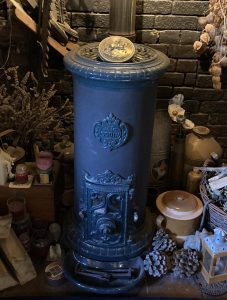
I have featured a number of different antique Godin stoves in my previous blogs, and it is not hard to see why they make such a great post. They are always so elegant and ornate and are usually found in different brightly coloured enamels. Indeed, many of these type of antique French stoves are manufactured in coloured enamels, which is part of there attraction and charm. This example is a Godin 3726 7Kw Wood-Burning Stove that I recently swept in Chrishall. As can be seen from the photographs, it is a beautiful stove, something like a piece of retro art. Yet, the customer tells me that it is regurlaly used of the winter months and heats the room most effectively. It certainly complements it surrounding, positioned as it is in the sitting room of a large, thatched property. As a sweep, I look forward to these moments when I come across examples of these antique French stoves, it really makes my day! Readers of my blog will know that I have posted about a number of these retro stoves in the past and which include makes such as Godin, Mirus and Faure Revin.
The Godin stove is the foundational of the history of French stove making, and indeed to the history of domestic stove manufacturing as a whole. Before the era of cast iron, domestic fuel took on many forms from the open hearth fire to the clay or stone kiln, but then the 23 year Godin started his business in 1840 making fireplaces in a shed in the centre of Thierache with a loan of about 4,000 francs from his parent, this quickly became too small.
The works soon moved to Guise where he started employing 30 people and in spite of fierce competition his business grew rapidly. The most important reason for this was his innovation. Godin applied for many patents for his products and concentrated on continually improving them both aesthetically and technically, making antique stoves from his era especially valuable.
Godin became a figure to know in French industrial relations. Godin offered his employees living wages or higher at a time of economic downturn, hired from a small pool of people in one geographical area reducing turn over and improving employee reliability.
By the end of the 1900’s, with a further 2000 employees, Godin was dominating the European stove market. Stove designs became ornate and stylised with the advent of the 20th century and the Art Nouveau and Art Deco movements. Godin’s stove design in this period did not become as elaborate and decorative as some other companies, such as Deville and Rosières, etc. But the stoves they produced in the early 20th century were, as always with Godin, extremely efficient and featured superb quality enamelling. Some of these original designs are still in production in the Godin factory today, laying testament to their design and efficiency.


 My name is Paddy McKeown, I am a retired police officer (Detective Sergeant – Metropolitan Police), turned chimney sweep. I have completed training with ‘The Guild of Master Chimney Sweeps’, and Rod Tech UK (Power Sweeping).
My name is Paddy McKeown, I am a retired police officer (Detective Sergeant – Metropolitan Police), turned chimney sweep. I have completed training with ‘The Guild of Master Chimney Sweeps’, and Rod Tech UK (Power Sweeping).




Comments are closed.